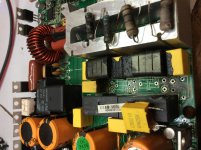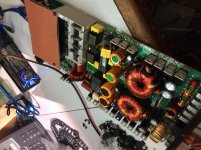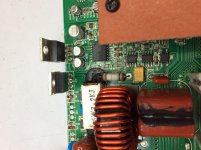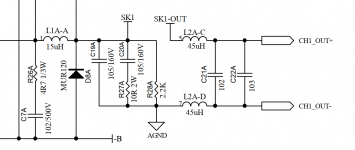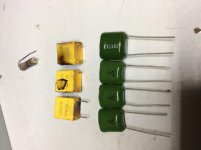Good day guys, I’m currently working on this amp but the zobel network resistors are burn beyond recognition, anyone have a schematic or know the resistor values for it?
Also resistor R42E is unidentifiable (I get a 203ohms across the resistor in an incircuit test).
Also resistor R42E is unidentifiable (I get a 203ohms across the resistor in an incircuit test).
Attachments
Are these caps any good to replace the ones I took from the amplifier? The amp is a full range amp, 4 channel out.
Is true that if the caps have no voltage identification, then it’s an 100v in maximum working voltage?
If those caps can be used, what would likely be the resistor value that I can use with them in that would be ok?
***Does the zobel network is the same as snubber network?
Is true that if the caps have no voltage identification, then it’s an 100v in maximum working voltage?
If those caps can be used, what would likely be the resistor value that I can use with them in that would be ok?
***Does the zobel network is the same as snubber network?
Attachments
100 v or maybe even 50v. Likely 100v for the green ones.
The type is very nearly identical. The casing is different. The function is essentially the same.
A Zobel helps stabilize an amplifier against inductive loads. A snubber damps spikes or ringing. I think this network is just to help clean up the output signal a bit. I don't know if it qualifies as either snubber or Zobel.
The type is very nearly identical. The casing is different. The function is essentially the same.
A Zobel helps stabilize an amplifier against inductive loads. A snubber damps spikes or ringing. I think this network is just to help clean up the output signal a bit. I don't know if it qualifies as either snubber or Zobel.
So likely the yellow caps (original) are 250v, can the 100v work in the amp (be advised that this amp isn’t for a customer, it’s used by the audio speaker dept. for testing speakers for sale for just a few moments at any given time).
Since the scenario is just momentarily, what value resistor could work?
Since the scenario is just momentarily, what value resistor could work?
Why not use the values on the diagram? If used as you described, it won't really matter. They would likely only overheat if the amp was abused. You can let it idle and see how hot they run. If they run hot, you likely have a shorted inductor. I'm assuming that these are after the output inductor.
- Status
- This old topic is closed. If you want to reopen this topic, contact a moderator using the "Report Post" button.
- Home
- General Interest
- Car Audio
- Precision Power P900.5 zobel problems
